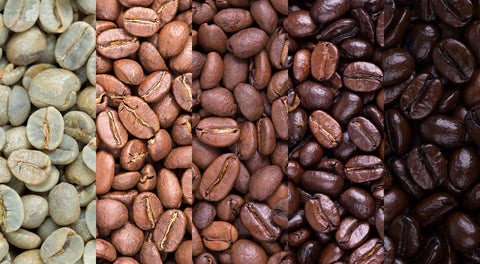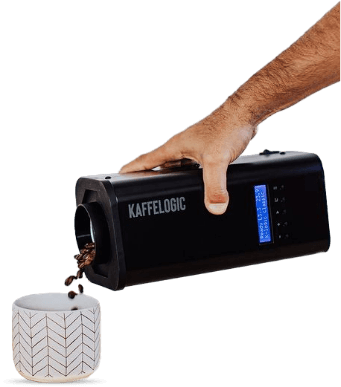
Everyone loves a good cup of coffee, but it’s common knowledge Australians place great importance on a flavourful and artisanal brew. If you're a coffee aficionado who loves the aroma of freshly brewed coffee, you've probably considered roasting your own green coffee beans at home.
But have you ever wondered about the additional benefits? With home espresso setups becoming increasingly popular, more and more coffee lovers are discovering the advantages of home-roasting their beans.
Green Bean Coffee is the top green coffee bean supplier in Australia, with close to 100 different varieties of coffee beans from around the world. In this comprehensive guide, we'll explore six compelling reasons why you should give it a try, from the financial savings to the unparalleled freshness and flavour control. So, grab a cup of your favourite brew and let's dive in!
Experience Unparalleled Freshness
Coffee lovers know that freshness is key to a perfect cup. When you roast your own raw coffee beans at home, you can experience a whole new level of freshness and flavour that simply can't be achieved with store-bought options.
In this section, we'll delve into the flavour difference between freshly roasted beans and store-bought options, discuss the optimal brewing window for peak freshness, and explain how home-roasted beans retain their freshness longer.
The Flavour Difference
When it comes to coffee, the time between roasting and brewing plays a crucial role in the overall taste and aroma of your drink. Store-bought beans, even those labelled as "freshly roasted," often sit on shelves for weeks or even months before reaching your home, resulting in a stale and less flavourful coffee. On the other hand, home-roasted beans are enjoyed at their peak freshness, boasting a rich, vibrant, and complex flavour profile that simply can't be replicated with pre-roasted beans.
You might be wondering: how does the freshness of my coffee beans affect the taste of my brew? Freshly roasted coffee beans result in a more vibrant and complex flavour, as the oils and aromatic compounds responsible for the unique characteristics of each coffee variety are at their peak. As coffee beans age, these compounds begin to break down, leading to a flat and less enjoyable taste. Additionally, stale beans can often develop off flavours, such as cardboard or mustiness, which can ruin the entire coffee-drinking experience.
The Optimal Brewing Window
To truly appreciate the freshness of home-roasted coffee, it's essential to understand the optimal brewing window. Generally, coffee beans reach their peak flavour within a few days to a week after roasting, during which they release the ideal balance of oils, acids, and aromatic compounds. By roasting your beans at home, you have the luxury of brewing your coffee within this optimal window, allowing you to savour the full spectrum of flavours and aromas that your beans have to offer.
Keeping Your Home-Roasted Beans Fresh
There are a few steps you can take to maintain the freshness of your home-roasted beans. While pre-roasted beans begin to lose their flavour and aroma as soon as they're exposed to air, home-roasted beans can retain their freshness for much longer when stored correctly. To keep your beans at their best, an airtight container will stop them from going stale. Along with this, try to keep them away from direct sunlight, heat, and moisture. By doing so, you'll extend the shelf life of your beans and ensure that each cup of coffee you brew is bursting with flavour!
A few extra tips:
- Roast in small batches: This ensures that you always have fresh coffee beans on hand without roasting more than you need.
- Allow your roasted beans to rest: After roasting, beans need time to develop their full flavour. It's generally recommended to wait at least 12-24 hours before brewing your first cup.
Support Sustainable and Ethical Coffee Practices
Brew a Better Future
When it comes to enjoying your daily cup of joe, it's essential to consider the impact your choices have on the environment and communities involved in coffee production. Supporting sustainable and ethical coffee practices is a fantastic way to make a positive difference, and home-roasting your green coffee beans is a key component in making this happen.
Ethically Sourced, Organic, or Fair-Trade Green Beans
Selecting ethically sourced, organic, or fair-trade green beans is a crucial aspect of promoting responsible coffee production. Ethically sourced beans ensure that the farmers are paid a fair wage and work in safe conditions. Organic beans are grown without harmful pesticides, protecting both the environment and the farmers' health. Fair-trade certification guarantees that strict social, environmental, and economic standards are met during production. When purchasing raw coffee beans, it's essential to research the suppliers and choose those who align with your values.
Reduce Waste and Embrace Reusable Packaging
Home-roasting can significantly reduce waste, as green beans have a longer shelf-life compared to pre-roasted beans. This means fewer trips to the store, reducing your carbon footprint. Additionally, you can store green beans in reusable containers, cutting down on single-use packaging. Investing in a quality coffee storage solution, such as an airtight container or reusable bag, will help maintain the freshness of your beans while minimising waste.
Supporting Small-Scale Coffee Farmers
By choosing to purchase beans directly from small-scale coffee farmers, you're contributing to their livelihood and the future of high-quality coffee production. These farmers often practise traditional, environmentally friendly methods and rely on coffee as their primary source of income. Supporting them not only encourages sustainable farming practices but also helps improve living standards within their communities. Researching and connecting with small-scale farmers or cooperatives can lead to discovering unique, ethically produced beans that you won't find in commercial stores.
Here are 3 of our favourite small-scale coffee suppliers:
Guatemala Organic RFA - Produced on a farm owned by the Echeverria family since the 1870s, this Arabica bean has beautiful malt toffee notes.
Dominican Republic Cibao Honey Processed - Harvested by brothers Bruno & Miguel Tejada, these honey processed beans feature a full-bodied flavour with tropical fruit flavours.
PNG PSC x Ukini Women’s Coffee - With 194 registered members, Ukuni 1 Women’s Coffee Association supports female growers and their families in impoverished areas in Papua New Guinea. These beans are a unique variety, with cocoa and macadamia notes shining through.

Control Your Coffee's Flavour Profile
A Personalised Coffee Experience
One of the most enticing aspects of home-roasting is the ability to take control of your coffee's flavour profile. As a home roaster, you have the power to experiment with various roast levels, bean origins, and blending techniques to create a coffee that is uniquely tailored to your taste preferences. This level of personalisation is nearly impossible to achieve with store-bought, pre-roasted beans, making home-roasting an exciting and fulfilling journey for coffee enthusiasts.
The Impact of Roast Levels on Flavour
Roast levels play a significant role in the flavour characteristics of coffee. Light roasts typically exhibit bright acidity and fruity notes, while medium roasts offer a balanced profile with mild acidity and a hint of sweetness. On the other hand, dark roasts tend to have bold, rich flavours with a smoky or chocolatey finish. By understanding the impact of roast levels on flavour, you can manipulate the roast to bring out your desired taste elements, such as fruitiness, acidity, or body.
Experimenting with Bean Origins and Blends
In addition to roast levels, bean origins and blending techniques can greatly influence the taste of your coffee. Each coffee-growing region produces beans with distinct flavour characteristics, ranging from fruity and floral notes in Ethiopian beans to nutty and chocolatey flavours in Brazilian beans. By experimenting with different bean origins and blending ratios, you can create a customised coffee experience that caters to your specific taste preferences.
Home Roasting with Kaffelogic Nano 7E
A good coffee roaster will offer precise temperature control and even heat distribution, ensuring consistent results. We recommend the Kaffelogic Nano 7E Home Roaster, for its range of amazing features.
Its large capacity allows you to roast up to 120 grams per roast, for plenty of delicious cups of coffee. The roaster comes with several default profiles to make roasting a breeze. However, for those who like to get technical, you can create your own custom roasting profiles and dial in exact roasting specifications.
Order now and receive 4 free sample packs of green beans!
Tips for Successful Home Roasting
To ensure a successful home-roasting experience, consider the following tips:
- Use a thermometer: Monitoring the temperature during roasting will help you achieve the desired roast level and avoid over-roasting or under-roasting your beans.
- Keep a roasting log: Documenting your roast levels, bean origins, and blending ratios will help you track your progress and perfect your coffee's flavour profile over time.
- Learn from others: Join online coffee forums or attend local workshops to learn from fellow home roasters and expand your knowledge of coffee roasting techniques.
In conclusion, taking control of your coffee's flavour profile through home-roasting is a rewarding and enjoyable experience that allows you to create a truly personalised coffee experience. By experimenting with roast levels, bean origins, and blending techniques, you can craft the perfect cup of coffee that caters to your unique taste preferences.
Adjust Caffeine Levels to Your Liking
The great debate among coffee enthusiasts often revolves around the best roast level, not just for taste, but also for caffeine content. As a coffee connoisseur, it's crucial to understand the relationship between roast level and caffeine content, so you can brew the perfect cup for yourself and your guests. Let's look into the intricacies of coffee roasting and how you can adjust caffeine levels to your liking.
Caffeine Content: Lighter vs. Darker Roasts
First, let's bust a common myth: darker roasts do not necessarily have more caffeine. In fact, the roasting process breaks down caffeine molecules, so lighter roasts typically contain slightly more caffeine than darker ones. The key is to find a balance between flavour and caffeine content, according to individual preferences.
Finding Your Perfect Roast
To determine the ideal roast level for your desired caffeine intake, consider experimenting with a few different types of beans and roast levels. You might start with a light roast for a brighter, more acidic flavour profile with slightly higher caffeine content. Gradually, try medium and dark roasts to experience their richer, bolder flavours and slightly lower caffeine content. By sampling various roast levels, you'll be able to identify which best suits your taste buds and caffeine requirements.
Catering to Individual Preferences
When hosting family members or guests, it's essential to consider their caffeine preferences and sensitivities. Some individuals may prefer a lighter roast with slightly more caffeine to kick-start their day, while others may opt for a darker roast with marginally less caffeine as an after-dinner treat.
Tips for Adjusting Caffeine Levels
- Experiment with blending: Combine different roast levels to create a unique blend that offers a perfect balance of flavour and caffeine content. For instance, mix a light roast with a dark one to achieve a medium-strength coffee with a balanced caffeine level.
- Adjust brewing methods: Different brewing methods can result in more or less caffeine in the final cup. For example, espresso brewing extracts more caffeine than drip coffee methods, even with the same roast level. Experiment with various brewing methods to find the perfect balance for you and your guests.
- Monitor serving size: Keep in mind that caffeine content in a cup of coffee depends not only on the roast level but also on the serving size. To cater to different preferences, consider adjusting the serving size rather than changing the roast level.
Save Money with Raw Beans
If you're looking to make a smart financial decision while indulging in your love for coffee, purchasing raw beans might just be the answer. These little gems come packed with potential and cost-saving benefits that you can't ignore.
The Price is Right: Green Beans vs. Pre-Roasted Beans
One of the most appealing aspects of unroasted coffee beans is their affordability. When compared to pre-roasted beans, you'll notice a significant difference in price. This is because raw beans haven't undergone the roasting process, which adds to their overall cost. By taking matters into your own hands and roasting at home, you'll be able to save a pretty penny without sacrificing quality or taste.
Take for example our best seller, the Ethiopian Yirgacheffe. By purchasing green beans and roasting at home, you’ll experience savings of nearly 40%!
Maximising Your Savings
If you're keen on saving even more money, consider buying unroasted coffee beans in bulk. Many suppliers offer discounts on larger quantities, which means you'll be able to stretch your dollar even further. And since green beans have a longer shelf life than their roasted counterparts, you won't have to worry about your supply going to waste.
Commercial coffee shops, take note: If you use 30 kilograms of coffee beans per week, you could save up to $20,000 per year!
Reducing Waste and Staying Fresh
Speaking of shelf life, green beans can be stored for several months without losing their quality or flavour. This is a stark contrast to pre-roasted beans, which can start to lose their freshness after just a couple of weeks. By roasting your own beans, you'll not only save money but also reduce waste and ensure that your coffee stays fresh and delicious.
When it comes to choosing between green beans and pre-roasted beans, it's clear that raw beans offer a wealth of benefits that can't be overlooked. From their affordability to their reduced waste, green beans are a smart choice for anyone looking to elevate their coffee experience without breaking the bank.
Conclusion
So, what are you waiting for? It's time to embrace the world of home-roasting and reap the financial benefits of using raw beans. As you explore different bean varieties and roasting techniques, you'll not only save money but also develop a deeper understanding of what goes into creating that perfect cup of coffee. And remember, you don't have to dive headfirst into the world of home-roasting – start small, experiment, and find what works best for you.
Whether you’re looking for coffee beans in Canberra, Newcastle, Cairns or anywhere else, Green Bean Coffee is the best supplier of coffee beans in Australia, in-store or online!
Happy roasting!
Frequently Asked Questions
How do I properly store my home-roasted coffee beans to maintain freshness?
Store your home-roasted beans in a container that is airtight, which will slow the process by which they become stale. Light, heat and moisture can also spoil beans, so keep them in a dark, cool and dry place. This will extend their shelf life and ensure that each cup of coffee you brew is bursting with flavour.
What is the relationship between roast level and caffeine content in coffee?
The roasting process breaks down caffeine molecules, so lighter roasts typically contain slightly more caffeine than darker ones. While there is not a large difference, those drinking multiple cups may benefit from a lower caffeine intake to avoid unwanted side effects.
How long should I wait before brewing coffee with freshly roasted beans?
It's generally recommended to wait at least 12-24 hours after roasting before brewing your first cup of coffee. Roasting produces a lot of CO2, which slowly releases after roasting. Brewing coffee beans straight from the roaster may result in woody or bitter flavours which can be unpleasant.
How can I control the flavour profile of my coffee when home-roasting?
By experimenting with various roast levels, bean origins, and blending techniques, you can create a coffee that is uniquely tailored to your taste preferences. We recommend recording the different factors you can control during roasting to create your very own roasting guide and combine your favourite aspects!
-
Prompt Delivery
-
Freshness Guaranteed
-
Personalised Service
-
Established in 2000

